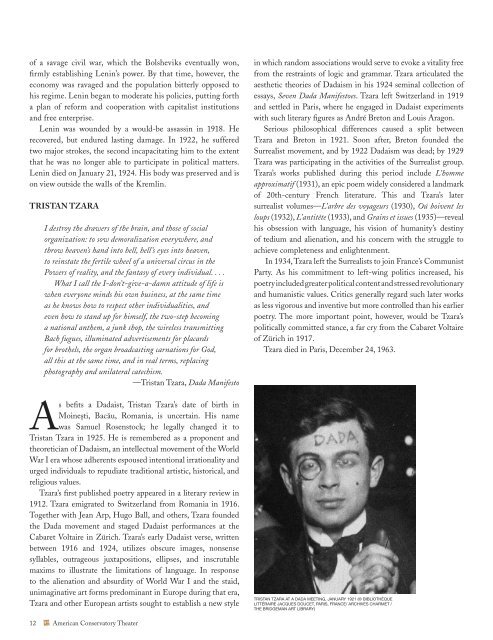by TOM STOPPARD Directed by CAREY PERLOFF - Convio
by TOM STOPPARD Directed by CAREY PERLOFF - Convio
by TOM STOPPARD Directed by CAREY PERLOFF - Convio
Create successful ePaper yourself
Turn your PDF publications into a flip-book with our unique Google optimized e-Paper software.
of a savage civil war, which the Bolsheviks eventually won,firmly establishing Lenin’s power. By that time, however, theeconomy was ravaged and the population bitterly opposed tohis regime. Lenin began to moderate his policies, putting fortha plan of reform and cooperation with capitalist institutionsand free enterprise.Lenin was wounded <strong>by</strong> a would-be assassin in 1918. Herecovered, but endured lasting damage. In 1922, he sufferedtwo major strokes, the second incapacitating him to the extentthat he was no longer able to participate in political matters.Lenin died on January 21, 1924. His body was preserved and ison view outside the walls of the Kremlin.TRISTAN TZARAI destroy the drawers of the brain, and those of socialorganization: to sow demoralization everywhere, andthrow heaven’s hand into hell, hell’s eyes into heaven,to reinstate the fertile wheel of a universal circus in thePowers of reality, and the fantasy of every individual....What I call the I-don’t-give-a-damn attitude of life iswhen everyone minds his own business, at the same timeas he knows how to respect other individualities, andeven how to stand up for himself, the two-step becominga national anthem, a junk shop, the wireless transmittingBach fugues, illuminated advertisements for placardsfor brothels, the organ broadcasting carnations for God,all this at the same time, and in real terms, replacingphotography and unilateral catechism.—Tristan Tzara, Dada ManifestoAs befits a Dadaist, Tristan Tzara’s date of birth inMoineşti, Bacău, Romania, is uncertain. His namewas Samuel Rosenstock; he legally changed it toTristan Tzara in 1925. He is remembered as a proponent andtheoretician of Dadaism, an intellectual movement of the WorldWar I era whose adherents espoused intentional irrationality andurged individuals to repudiate traditional artistic, historical, andreligious values.Tzara’s first published poetry appeared in a literary review in1912. Tzara emigrated to Switzerland from Romania in 1916.Together with Jean Arp, Hugo Ball, and others, Tzara foundedthe Dada movement and staged Dadaist performances at theCabaret Voltaire in Zürich. Tzara’s early Dadaist verse, writtenbetween 1916 and 1924, utilizes obscure images, nonsensesyllables, outrageous juxtapositions, ellipses, and inscrutablemaxims to illustrate the limitations of language. In responseto the alienation and absurdity of World War I and the staid,unimaginative art forms predominant in Europe during that era,Tzara and other European artists sought to establish a new stylein which random associations would serve to evoke a vitality freefrom the restraints of logic and grammar. Tzara articulated theaesthetic theories of Dadaism in his 1924 seminal collection ofessays, Seven Dada Manifestoes. Tzara left Switzerland in 1919and settled in Paris, where he engaged in Dadaist experimentswith such literary figures as André Breton and Louis Aragon.Serious philosophical differences caused a split betweenTzara and Breton in 1921. Soon after, Breton founded theSurrealist movement, and <strong>by</strong> 1922 Dadaism was dead; <strong>by</strong> 1929Tzara was participating in the activities of the Surrealist group.Tzara’s works published during this period include L’hommeapproximatif (1931), an epic poem widely considered a landmarkof 20th-century French literature. This and Tzara’s latersurrealist volumes—L’arbre des voyageurs (1930), Oú boivent lesloups (1932), L’antitête (1933), and Grains et issues (1935)—revealhis obsession with language, his vision of humanity’s destinyof tedium and alienation, and his concern with the struggle toachieve completeness and enlightenment.In 1934, Tzara left the Surrealists to join France’s CommunistParty. As his commitment to left-wing politics increased, hispoetry included greater political content and stressed revolutionaryand humanistic values. Critics generally regard such later worksas less vigorous and inventive but more controlled than his earlierpoetry. The more important point, however, would be Tzara’spolitically committed stance, a far cry from the Cabaret Voltaireof Zürich in 1917.Tzara died in Paris, December 24, 1963.TRISTAN TZARA AT A DADA MEETING, JANUARY 1921 (© BIBLIOTHÈQUELITTÉRAIRE JACQUES DOUCET, PARIS, FRANCE/ ARCHIVES CHARMET /THE BRIDGEMAN ART LIBRARY)12 American Conservatory Theater


